The science behind Hawai‘i’s bubbling lava
 Lava advances along a street near a fissure in Leilani Estates, on Kilauea Volcano's lower East Rift Zone, Hawaii, the U.S., May 5, 2018. Image courtesy of the U.S. Geological Survey (USGS)/Handout via REUTERS.
Lava advances along a street near a fissure in Leilani Estates, on Kilauea Volcano's lower East Rift Zone, Hawaii, the U.S., May 5, 2018. Image courtesy of the U.S. Geological Survey (USGS)/Handout via REUTERS.Hawai‘i emergency crews continue to battle lava flow and hazardous sulfur dioxide fumes, four days after the Kilauea volcano erupted on the big island. The slow-moving lava has destroyed 35 structures so far, including at least 26 homes; no fatalities have been reported. Amna Nawaz of the PBS News Hour talks with Geology and Geophysics (G&G) professor Michael Garcia.
In response to Nawaz’s question whether “we had any sign that this was coming”, Garcia said,
“Well, many different techniques are utilized, particularly ground deformation, earthquakes, and even the gas that are being released from the volcano. So a variety of different kinds of techniques are utilized to try and understand what’s going on at depth. And sometimes we’re caught off-guard in terms of, like in this case, that the eruption would leave the locations where you had two active vents.
You had a lava lake the last 10 years at the summit of the volcano. You had an active vent for 35 years on the middle of the east rift zone. Both of those things have lost their magma flow. And instead the lava is drained down the rift zone and then popped up 20 kilometers away from where it was erupting previously.”
Watch the video at PBS News Hour.




